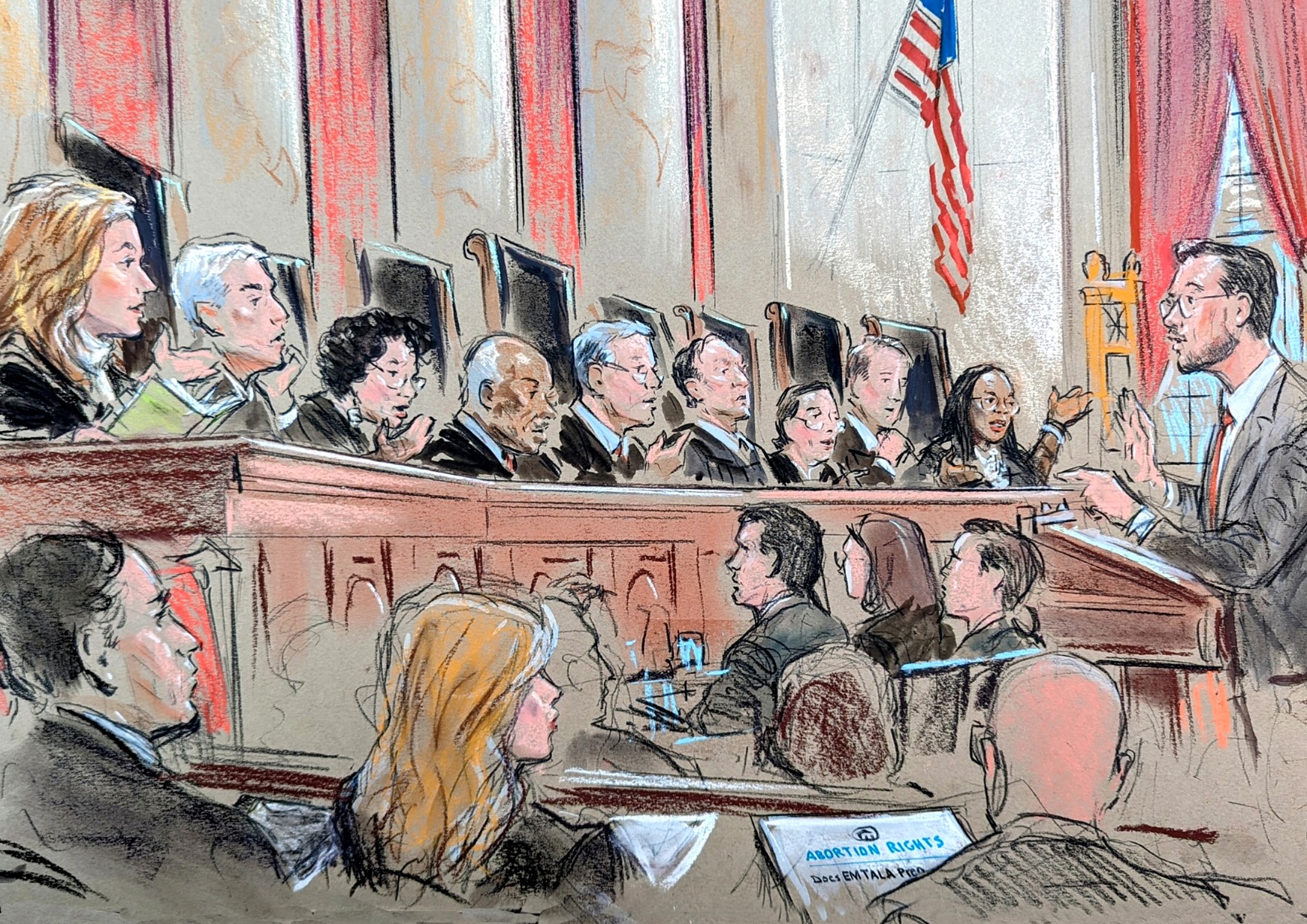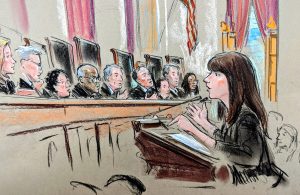ARGUMENT ANALYSIS
Supreme Court divided over federal-state conflict on emergency abortion ban

on Apr 24, 2024 at 3:45 pm

The Supreme Court on Wednesday was divided over whether a federal law requiring hospitals that participate in Medicare to provide “necessary stabilizing treatment” in an emergency overrides an Idaho law that bars most abortions.
The court’s ruling could affect health care in emergency rooms in the 22 states that have imposed restrictions on abortions, particularly in the six states that – like Idaho – lack exemptions to the general ban to protect the health of the mother.
The federal law at the center of the case is known as the Emergency Medical Treatment and Labor Act. Passed in 1986, the law was intended to ensure that all patients have access to emergency services without regard to their ability to pay for those services. And in particular, EMTALA provides that when someone with an “emergency medical condition” comes to a hospital that participates in Medicare, the hospital must offer the treatment necessary to stabilize that condition.
Shortly after the Supreme Court’s 2022 decision in Dobbs v. Jackson Women’s Health Organization, overturning the constitutional right to an abortion, the Biden administration went to federal court in Idaho. It argued that EMTALA trumps an Idaho law that generally makes it a crime to provide an abortion except in a handful of circumstances, such as to save the life of the mother or in cases of rape or incest.
A federal judge agreed with the Biden administration and barred the state from enforcing its abortion ban to the extent that it conflicted with EMTALA. After a divided U.S. Court of Appeals for the 9th Circuit declined to put that order on hold, the state and its Republican-controlled legislature came to the Supreme Court, which agreed earlier this year to allow Idaho to enforce the law and to weigh in on the merits of the dispute.
Representing the state, Idaho Solicitor General Joshua Turner told the justices that nothing in EMTALA requires doctors to provide treatments that violate state law. Turner urged the court to reject the federal government’s “unlimited” reading of EMTALA – which, he contended, would apply not only to abortion but also to laws regulating opioid treatments and to informed consent laws, among others.
U.S. Solicitor General Elizabeth Prelogar offered a very different view of EMTALA, characterizing it as a law whose “promise is simple but profound.” The law was intended to ensure that hospitals do not deny treatment to any patients who arrive at the emergency room. In cases in which there is no other way to stabilize a pregnant woman and prevent her health from deteriorating, Prelogar said, abortion is the appropriate care that hospitals must provide – even if Idaho can enforce its ban in virtually every other circumstance.
The court’s three liberal justices repeatedly pressed Turner on the state’s interpretation of EMTALA, emphasizing a variety of scenarios in which Idaho would not allow a pregnant woman to obtain an abortion. Justice Ketanji Brown Jackson described what she saw as a direct conflict between EMTALA and Idaho’s abortion ban. EMTALA, she said, provides that hospitals must provide treatment to stabilize a patient’s health, but – if abortion is involved – Idaho prohibits such treatment unless it is necessary to prevent death.
Justice Elena Kagan echoed Jackson’s concerns, asking Turner about a scenario in which a pregnant woman arrives at the emergency room with a serious health condition that will not lead to her death, but – without an abortion – will result in her being unable to have more children. A variety of scenarios exist, Kagan and her liberal colleagues repeatedly stressed, in which a pregnant patient, though not at risk of dying, could be in a state of medical distress that, without receiving an abortion, might lead to loss of organs, loss of fertility, or a need for lifelong treatments like dialysis. EMTALA, Kagan stressed, would require the hospital to perform an abortion, but Idaho would not permit it.
Turner conceded that such a situation would be “very difficult” and raise “tough medical questions.” But Kagan was not mollified by that response, countering that federal law already addresses the question, providing that doctors don’t have to wait until the pregnant woman is ready to die.
Justice Sonia Sotomayor asked Turner to address a series of rapid-fire hypotheticals involving pregnant women, including a patient whose problems began during her 14th week of pregnancy but were not sufficiently serious to warrant an abortion, leading to her delivery of the baby at 27 weeks and a hysterectomy, so that she could not have any more children.
Turner posited that doctors in Idaho could perform abortions in some of the circumstances that Sotomayor outlined, telling the court that physicians would not need “medical certainty” that a patient would die to perform an abortion.
Turner’s assurances led to a series of questions from the court’s conservative justices. Some of them, like Justice Amy Coney Barrett and Chief Justice John Roberts, focused on how the law would actually operate in practice under Turner’s description. Would doctors who make the decision to perform an abortion, Barrett asked, be prosecuted under Idaho law? And has Idaho issued any kind of guidance to assist doctors in making these kinds of decisions?
Roberts shared Barrett’s concerns, asking Turner who makes decisions about whether an abortion would be covered under Idaho law under this standard.
Turner explained that the state’s Board of Medicine oversees the licensing of Idaho physicians, and that the board looks at whether a doctor made the decision in good faith.
Other justices looked at a broader issue: whether there is in practice any real conflict between EMTALA and the Idaho ban in light of a ruling by the Idaho Supreme Court that narrowed the scope of the law, so that EMTALA would not override it. Justice Brett Kavanaugh asked Turner to focus on “the actual dispute as it exists now.” For each of the conditions that the federal government identifies as requiring abortion as a stabilizing treatment, Kavanaugh observed, the state now contends that Idaho law actually would permit an abortion. Is there any condition, Kavanaugh queried, where Idaho law would not allow an abortion? And if not, Kavanaugh continued, what would that mean for this case?
Turner responded that although the federal government maintains that abortion is not the only stabilizing care for mental health conditions, the American Psychiatric Association indicates that abortions are “imperative for mental health conditions.”

U.S. Solicitor General Elizabeth Prelogar argues for the government. (William Hennessy)
Prelogar pushed back against any suggestion that there is no gap between the care that EMTALA requires and what Idaho law allows. She told the justices that “the situation on the ground in Idaho is showing the devastating consequences of that gap,” as emergency rooms in Idaho are faced with the unpalatable choice of waiting for a pregnant woman’s condition to deteriorate enough so that they can provide abortions or transferring her to another state entirely – which, she said, hospitals in the state are currently doing once every other week.
Addressing Turner’s contention that mental health conditions would not be covered by Idaho law, Prelogar insisted that in grave mental health emergencies providing an abortion would not be the proper medical practice and further would not do anything to address the underlying mental health condition, which would be treated with psychiatric medication. A patient in a mental health emergency may not be able to provide informed consent to an abortion. So although an “emergency medical condition” can include mental health problems, she said, it would not be the government’s practice to include abortion as care that would be required in such a situation.
Prelogar faced a barrage of questions from the court’s conservative justices about whether the government can supersede Idaho’s general abortion ban by imposing conditions on the recipients of federal funds – here, the hospitals that entered into Medicare contracts. Both Justice Clarence Thomas and Alito raised this question, with Thomas asking Prelogar to identify other legislation under the Constitution’s spending clause that preempts criminal law. Thomas and Alito also questioned whether the federal government can supersede a state’s laws when the state did not enter into the contract with the federal government (and therefore did not agree to the conditions imposed by the government).
Justice Neil Gorsuch expressed concern about the scope of the government’s power to place conditions on federal spending. Could the federal government, Gorsuch asked, condition the receipt of funds by hospitals on their compliance with federal medical malpractice and licensing requirements?
Barrett suggested that it was “odd” that a private entity could circumvent state law though a side agreement with the federal government. Could Congress use its authority under the spending clause to regulate or prohibit other kinds of medical care, she asked, such as gender reassignment surgery, or to ban abortion across the country?
Prelogar acknowledged that Congress has “broad authority through the spending clause.”
Gorsuch then appeared doubtful about the federal government’s need to seek an injunction barring Idaho from enforcing its ban at all. He told Prelogar that EMTALA is a “reticulated statute” that allows the government to seek remedies such as fines for noncomplicance. “Congress has given you lots of tools,” he told Prelogar.
Alito complained, with about 30 minutes left in the nearly two-hour argument, that the attorneys and the justices had “hardly” mentioned EMTALA’s reference to the “unborn child,” suggesting that it was an odd phrase to put in a statute that, on the government’s reading, is supposed to require abortions? In Alito’s view, the inclusion of the phrase indicated that the statute imposes a duty not only to the pregnant woman, but also to the unborn child. But the government, he said, was asking the justices to interpret “a statute signed by Ronald Reagan” as imposing a duty to perform an abortion even when doing so would be contrary to state law.
Barrett and Roberts both asked about the interaction between EMTALA and “conscience objections” – whether either doctors or hospitals could decline to perform abortions based on their religious or moral beliefs.
Prelogar told the court that both hospitals and physicians could assert a conscience objection, and that “EMTALA does not override either set of conscience protections.” In response to a follow-up question from Roberts, she explained that hospitals make their staffing decisions to ensure that someone who is able to provide care is on call. “[I]f the question is could you force an individual doctor to step in then over a conscience objection, the answer is no.” However, she acknowledged, if a hospital repeatedly did not have someone available to run its emergency room, including providing abortions in an emergency, it was possible that the federal government could eventually “terminate the Medicare funding agreement.”
A decision in the case is expected by summer.
This article was originally published at Howe on the Court.


